October, 1969
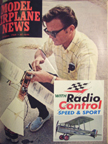
Model Airplane News Cover for October, 1969
Fokker Spin ("Spider") Click to Enlarge
Here is what the blurb about the cover has to say:
"... Freeflighter Robert Jones attempting to start his 0.020 powered Fokker Spiker [sic] III. This vintage plane, 1911, is an excellent free-flight subject but Bob did not have much luck this day as he could not manage an engine start for an official flight .. upper [sic] right hand corner we see Top Flite's fabulous SE-5A latest in their line of Radio Control kits..."
Note: MAN's typographical gremlin was working overtime -- the correct name of Mr. Fokker's very first effort is the Spin" or "Spider" (see below for details) Next, the box with the SE-5A is in the lower right hand corner
About the Fokker Spin (or "Spider")
The Fokker Spin was the first airplane built by Anthony Fokker. The many bracing wires made the plane resemble a giant spider, hence its name Spin (Dutch for "spider"). Fokker, while studying in Germany, built the Spin in 1910 together with Jacob Goedecker and business partner Franz von Daum, who procured the engine. The plane started out as an experimental design to provide Fokker a means to explore his interest in flying. While the first Spin was destroyed when von Daum flew it into a tree, the engine was still salvageable and was used in the second version. A second version of the Spin was built soon afterwards, in which Fokker taught himself to fly and earned his pilot license.
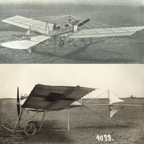
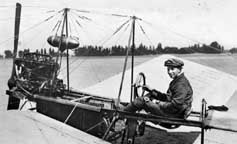
Fokker Spin (or "Spider")
Click to Enlarge
In Fokker's third model, he gained fame in his home country the Netherlands by flying around the tower of the Sint-Bavokerk in Haarlem on August 31, 1911. He further added to his fame by flying on the birthday of Queen Wilhelmina. After this success he founded an aircraft factory and flight school near Berlin. There, the M.1 through M.4 were developed for the German Army based on the Spin.
The fuselage simply consists of two wooden beams with cross members on which the pilot is seated and on which an Argus four-cylinder water-cooled engine is mounted in the front. The radiators are placed on the side of the fuselage. The wings and tail consist of two steel tubes with bamboo ribs. The landing gear is also constructed of steel tubing. The whole structure is held together with steel wire. Later versions have a more streamlined fuselage.
The M.1 was a two-seat monoplane built in small numbers as the M.3. It was first flown in 1911 and by 1913 had been transferred to military flying schools. The M.2 was a true military version of the Spin with a 100 hp engine and was capable of 60 mph). The ten M.2s ordered for 299,880 Marks included 10 Daimler trucks to move the aircraft with the Army, per plans of the German General Staff at the time. The M.2 was a much refined aircraft with a streamlined fuselage, first flown in 1912. The M.4 was developed from the M.3, and included a nose wheel. It did not gain further sales. From 1912 to 1913, a total of 25 Fokker Spins were built (including a few two-seat variants), used mostly for pilot training.
Here is a video of a reproduction of the Spin made in honor of Anthony Fokker.:
Click Here to learn more about the Fokker Spin.
About the Royal Aircraft Factory SE-5A
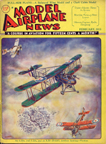
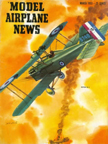
Royal Aircraft Factory SE5A
Model Airplane News Cover Art for February, 1932 and March, 1953
by Jo Kotula
Click to Enlarge
The S.E.5 (Scout Experimental 5) was designed by Henry P. Folland, J. Kenworthy and Major F.W. Goodden of the Royal Aircraft Factory, in Farnborough. The first of three prototypes flew in 1916. The first two prototypes were lost in crashes (the first killing Major Goodden) due to a weakness in their wing design. The third prototype corrected the faults in the first two - the S.E.5 became known in service as an exceptionally strong aircraft which could be dived at very high speed.
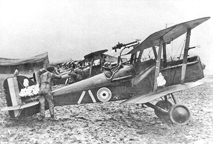

Photos of the Royal Aircraft FactorySE-5-a
Click to Enlarge
Like the other significant Royal Aircraft Factory aircraft of the war (B.E.2, F.E.2 and R.E.8) the S.E.5 was inherently stable, making it an excellent gunnery platform, but it was also quite manoeverable. It was one of the fastest aircraft of the war, at 138 mph equal at least in speed to the SPAD S.XIII, and faster than any standard German type of the period. The S.E.5 was not as effective in a dog fight as the Sopwith Camel, as it was less agile, but it was easier and safer to fly, particularly for novice pilots.
The S.E.5 had only one synchronised .303-in Vickers machine gun to the Camel's two. However it did have a wing-mounted Lewis gun that enabled the pilot to fire at an enemy aircraft from below, as well as forward. This was much appreciated by the pilots of the first S.E.5 squadrons, as the synchronising gear for the Vickers was unreliable at first. The Vickers gun was mounted on the left side of the fuselage with the breech inside the cockpit. The cockpit was set amidships, making it difficult to see over the long front fuselage, but otherwise visibility was good. Perhaps its greatest advantage over the Camel was its superior performance at altitude - so that (unlike most Allied fighters) it was not outclassed by the Fokker D.VII when that fighter arrived at the front.
Here is a video of the Royal Aircraft FactorySE-5-a in action:
Jo Kotula revisited the S.E. 5 in the "Box Art" for the Aurora kit.
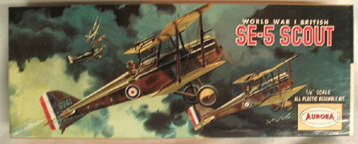
Aurora Plastic Model of the R.A.F S.E. 5
Artwork by Jo Kotula
Click to Enlarge
Click Here for more information about the Royal Aircraft FactorySE-5-a.

Click to go back and select another cover.
Counter for the Entire Site (not just this page..)
Home | About Lindy | Last Week's Reviews | Upcoming Events | 1940s Collecibles
The Guide - Establishments - Travel - Accessories
Music | Links | Photo Gallery | Extras | Contact